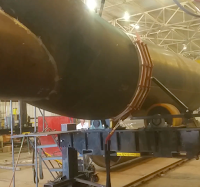For more information, visit http://www.hotfoilehs.com or call 609.588.0900.
A blog that provides educational information on electric heating systems used on hoppers, chutes, tanks and vessels; electric heating systems used for pre and post weld heat treating; heat treating power consoles; custom heat treating furnaces; and single & multi-operator welders. For more information, visit HotfoilEHS.com
Electric Process Heaters & Controls
Hotfoil specializes in electric surface heating systems for fly ash hoppers on electrostatic precipitators or baghouses, coal and material handling systems, tanks, pipes, etc. in all types of industry.
For more information, visit http://www.hotfoilehs.com or call 609.588.0900.
For more information, visit http://www.hotfoilehs.com or call 609.588.0900.
Fuel Based Furnace Types and Applications
 |
| Large furnace in production (Hotfoil-EHS) |
Fuel-based process heating systems are common in nearly every industry segment, and include furnaces like ovens, heaters, kilns, and melters, but also the surface treatment in ambient air. Typical fuel-based furnaces include the following:
- Atmosphere generators. Used to prepare and/or condition protective atmospheres. Processes include the manufacture of endothermic gas used primarily to protect steel and iron during processing, and exothermic gas used to protect metals, but also to purge oxygen or volatile gases from con ned areas.
- Blast furnaces. Furnaces that burn solid fuel with a blast of air, often used to smelt ore.
- Crucible furnaces. A furnace in which the heated materials are held in a refractory vessel for processes such as melting or calcining.
- Dryer. A device that removes free water, or other volatile components, from materials through direct or indirect heating. Dryers can be grouped into several categories based on factors such as continuous versus batch operation, type of material handling system, or source of heat generation.
- Indirect process heaters. Used to indirectly heat a variety of materials by remotely heating and circulating a heat transfer uid.
- Kilns. A furnace used to bake, dry, and re ceramic ware or wood. Kilns are also used for
calcining ores.
Heat treating furnace (Hotfoil-EHS) - Lehrs. An enclosed oven or furnace used for annealing, or other forms of heat treatment, particularly in glass manufacturing. Lehrs may be the open type (in which the flame comes in contact with the ware), or the muffle type.
- Muffle furnaces. A furnace in which heat is applied to the outside of a refractory chamber or another enclosure containing the heated material that is enveloped by the hot gases. The heat must reach the charge by flowing through the walls of the container.
- Ovens. A furnace-like chamber in which substances are heated for purposes, such as baking, annealing, curing, and drying. Heated systems can use forced convection or infrared.
- Radiant-tube heat-treating furnaces. Used for processing iron, steel, and aluminum under a controlled atmosphere. The flame is contained within tubes that radiate heat to the work. Processes include carburizing, hardening, carbo-nitriding, and austempering. The atmosphere may be inert, reducing, or oxidizing.
- Reverberatory furnaces. Furnaces in which open flames heat the upper portion of a chamber (crown). Heat is transferred to the material mainly by radiation ( flame, reflection of the flame by the crown) and convection (combustion gases).
- Salt bath furnaces. Metal pot furnaces filled with molten salt where heat is applied to the outside of the pot or inside of the pot by radiant tube. Salt bath furnaces are used for processes such as heat treating metals and curing plastics and rubber.
- Solid waste incinerators. Used to dispose of solid waste material through burning.
- Thermal oxidizers. Used to oxidize volatile organic compounds (VOC) in various industrial waste streams. Processes include paint and polymer curing and/or drying.
Induction Heating Basics
 |
| Induction heating coils around large pipe for pre-weld heat treatment. |
Direct Induction
Direct induction heating occurs when the material to be heated is in the direct alternating magnetic field. The frequency of the electromagnetic field and the electric properties of the material determine the penetration depth of the field, thus enabling the localized, near-surface heating of the material.
Comparably high power densities and high heating rates can be achieved. Direct induction heating is primarily used in the metals industry for melting, heating, and heat treatment (hardening, tempering, and annealing).
Indirect Induction
Indirect Induction
With indirect induction heating, a strong electromagnetic field generated by a water- cooled coil induces an eddy current into an electrically conducting material (susceptor), which is in contact with the material to be treated. Indirect induction heating is often used to melt optical glasses in platinum crucibles, to sinter ceramic powders in graphite crucibles, and to melt materials in crucibles prior to drawing crystals. Indirect induction is also used to heat susceptors used for joining operations.
Subscribe to:
Posts (Atom)